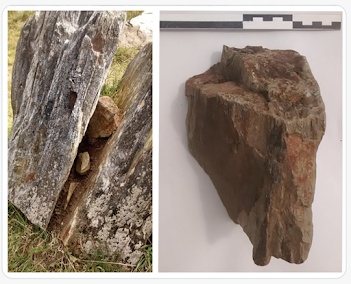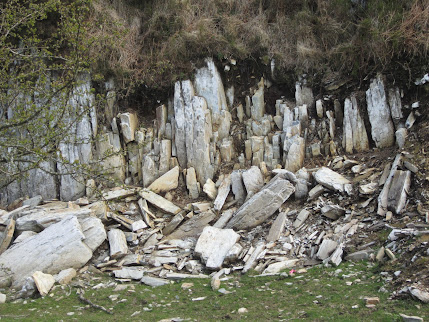Thanks to various kind people, I now have several copies of the new article about imaginary wedges, published in the Journal of Archaeological Science! Not to put too fine a point on it, this is probably the least scientific paper I have ever read in a learned journal, and it is amazing that it has made its way through a refereeing and editing process and ended up as a publication. On my first reading I thought it had to be a practical joke -- but now I suppose we have to take it seriously since others who know nothing of Rhosyfelin and Carn Goedog will simply assume that it is reliable......
The details again:
Reconstructing extraction techniques at Stonehenge’s bluestone megalith quarries in the Preseli hills of west Wales,
Mike Parker Pearson, Richard Bevins, Nick Pearce, Rob Ixer, Josh Pollard, Colin Richards, Kate Welham
Journal of Archaeological Science: Reports, Volume 46, 2022, 103697,
https://doi.org/10.1016/j.jasrep.2022.103697
In the very first paragraph the inherent bias of the authors is flagged up when they assume that most, if not all, megalithic monuments are linked with quarries. How's this for a throwaway line? "In the case of Stonehenge, the distance from quarry to eventual destination is the maximum known for megalithic monuments anywhere in the world (Parker Pearson et al., 2020a)." That sets the scene for the whole article, and we know that everything that follows is going to be part of an exercise in quarry confirmation.
There follows an extended exercise in self-citation, relating to the nature of the bluestones and their possible provenances. (Interestingly, the main "possible" and "probable" provenances examined in earlier publications have now become matters of fact in the eyes of the authors, although they do admit that many of the bluestone sources are still a matter of speculation.) They fail to mention that there are at least 46 different rock types in the Stonehenge bluestone assemblage, and that this fact alone strongly mitigates against a dependence upon quarried stone sources.)
In the section on "megalith extraction" at Carn Goedog we find a summary of the evidence and speculations contained in the 2019
Antiquity paper -- so it's full of highly dubious statements about "quarrying" features and techniques, without any attempt to examine alternative explanations for the morphology of the rock faces or the sediments examined. And as in other papers dealing with Carn Goedog, there is a highly convoluted use of radiocarbon dates to enforce a desired chronology, while the authors conveniently ignore all the dates that are not convenient. I won't go through my detailed critique, because I have done it before, on this blog. But the authors could, and should, have cited my 2019 paper (on Researchgate) entitled "Carn Goedog and the question of the “bluestone megalith quarry” because it directly addresses many of the claims made about quarrying.
https://www.researchgate.net/publication/332739336_Carn_Goedog_and_the_question_of_the_bluestone_megalith_quarry Then we get to the main part of the article, on Craig Rhosyfelin, and from here on in, it's all downhill. The authors do at least admit that there are no Rhosyfelin rhyolite monoliths at Stonehenge, but they make it clear from the outset that this is -- in their minds -- a Neolithic bluestone monolith quarry, even if they have no idea where the monoliths went and even though foliated rhyolite is anyway a lousy rock type for standing stones. Again, much of the text here is simply a resume of the contents of multiple other papers by the same group of authors, and the text here is packed with speculations and assertions that are unsupported by hard evidence. We have analysed the shortcomings of the presented evidence and questioned a whole host of dodgy conclusions on many occasions on this blog.
But then we get to a much more serious problem. This is supposed to be a serious scientific paper, and an obligation is placed on all authors of such publications to honestly cite sources and evidence that might not be convenient for the hypothesis under consideration. Yet nowhere is there any mention of the two peer-reviewed papers published by Dyfed Elis-Gruffydd, John Downes and myself in 2015 -- and there is no consideration either of the points of interpretation which are disputed. That is cowardly and disrespectful, and the editor of this Journal should not have allowed Parker Pearson and his fellow authors to get away with it.
As with Carn Goedog, the radiocarbon evidence (which many independent observers see as conclusively falsifying the quarrying hypothesis) is manipulated and selectively used to reinforce the desired timetable of events.
The bulk of the article deals with so-called "stone wedges" at the two so-called quarrying sites. It all looks very scientific, since there are tables, bivariate plots, principal component analyses, annotated photos and so forth. As usual, the authors cannot resist telling us what to believe instead of presenting us with evidence and letting us draw our own conclusions. So they tell us that they have found three notable stone wedges when we simply see angular and flattish fragments of shale, mudstone and foliated rhyolite which are indistinguishable from thousands of others in their so-called "quarries". They say they have evidence of splitting, scratching and percussion damage on the wedges, but that is not adequately demonstrated, and from my knowledge of both sites I can say that I have picked up scores of similar stone fragments with wedge shapes, scratches and surface damage from fissures, cracks, fractures, gaps and exposed sediment surfaces right throughout the excavated area. From what we can see, there is nothing at all unusual or notable about the "stone wedges" numbered SF134, 135, 136 and 137 which are subjected to detailed analysis.
A huge amount of work has been put into the pXRF work on the so-called wedges and their "host cracks", with the authors then claiming that the wedges were probably not derived from the walls of the cracks. In the minds of the authors: "geochemical analysis reveals that these and the third wedge are of compositions different to the rock on either side of the cracks into which they had been driven, confirming their identification as quarrying tools."
Plots of the Xray readings for the so-called wedges, set against the plots for multiple bedrock sites at Rhosyfelin. What do they tell us? That the lumps of rock concerned did not necessarily come from the walls of the cracks they were found in. But we knew that already.......
That is a wildly irresponsible assertion, bordering on scientific fraud, because the authors fail, anywhere in their text, to tell us that rockfall debris is the principal component of the rock face at Rhosyfelin and the inner part of the excavated area. Almost every crevice and fracture is filled with debris which has fallen from above or been forced in from the side during thousands of years of sediment accumulation. Many of the fragments in this debris are broken and scratched. The authors pretend that "colluvium" is the sediment that might be expected to wrap around the wedges in cracks and crevices, but that is an absurd distortion of the truth.
Rockfall debris is the principal component of this site, with a constant supply of broken rock fragments and soil associated with the degradation of the crag. Additional debris has been brought into the dig site by glacial and fluvioglacial processes. needless to say, many of the fragments are sharp-edged, wedge shaped, scratched and damaged by percussion events.Quote: "We are fortunate that Carn Goedog and Craig Rhos-y-felin have preserved good evidence in the form of stone tools as well as features such as artificial platforms, the recesses left by extracted monoliths and, especially, the cracks into which stone wedges were hammered." One fantasy after another, relating to "worked stone assemblages", "soft-hammer percussion" and much else besides........
The final section of the paper, relating to other "quarrying sites" in Europe, may or may not be reliable. I'll leave that for others to decide! But these are the last words:
"
Wedges SF136 and SF137 were positioned so as to extract a pillar directly beside the recess from which we reckon a monolith was removed and taken to Stonehenge. This was quite possibly the buried stump Stone 32d within the Bluestone Circle. Just why that second pillar was never removed from the Craig Rhos-y-felin outcrop is unknown. Was it surplus to requirements? Was it too securely attached to be worth the effort of extraction? Or was it considered to be structurally unsound? Such questions may seem insignificant against the larger one of just why the bluestones were taken 240 km (170 miles) to Stonehenge but the close interrogation of quarrying methods and technology is a small step towards reconstructing the context of that extraordinary event."
I am lost in admiration. It is not often that one encounters such fertile imaginations, or such vast amounts of effort devoted to finding out nothing of any interest. So what a sad waste of time. After all, there are no known foliated rhyolite monoliths at Stonehenge, and this material was hardly ever used in stone settings in Pembrokeshire either. And why would our heroic Neolithic ancestors go to all this trouble of wedging, hammering and levering furiously in a highly inconvenient location when, if they wanted some nice stones, all they had to do was pick them up from the rockfall debris or from the surrounding landscape and carry them away?
========================






4 comments:
Here's a couple of words, one an adjective, the other a noun, that fit Michael Parker Person to a T.
vainglorious: as in victorious fabrication
fabulist: purveyor of myths
vainglorious: example of useage:- "this vainglorious boast of personal infallibility"
Its fake archaeology. And that geezer's right, IMHO. Why are we wasting time with this nonsense.
You have a point, Steve. A part of me thinks "This is all such nonsense that surely it would be best just to ignore it?" But then I realise that people are incredibly gullible and that they believe anything that is contained in a press release or shown on the telly. Even among the experts in this field, how many people actually read learned papers these days? Remarkably few, I suspect. And it is into that vacuum that MPP and his merry gang feed their corrupt narrative, knowing that they will probably get away with it.......
Post a Comment